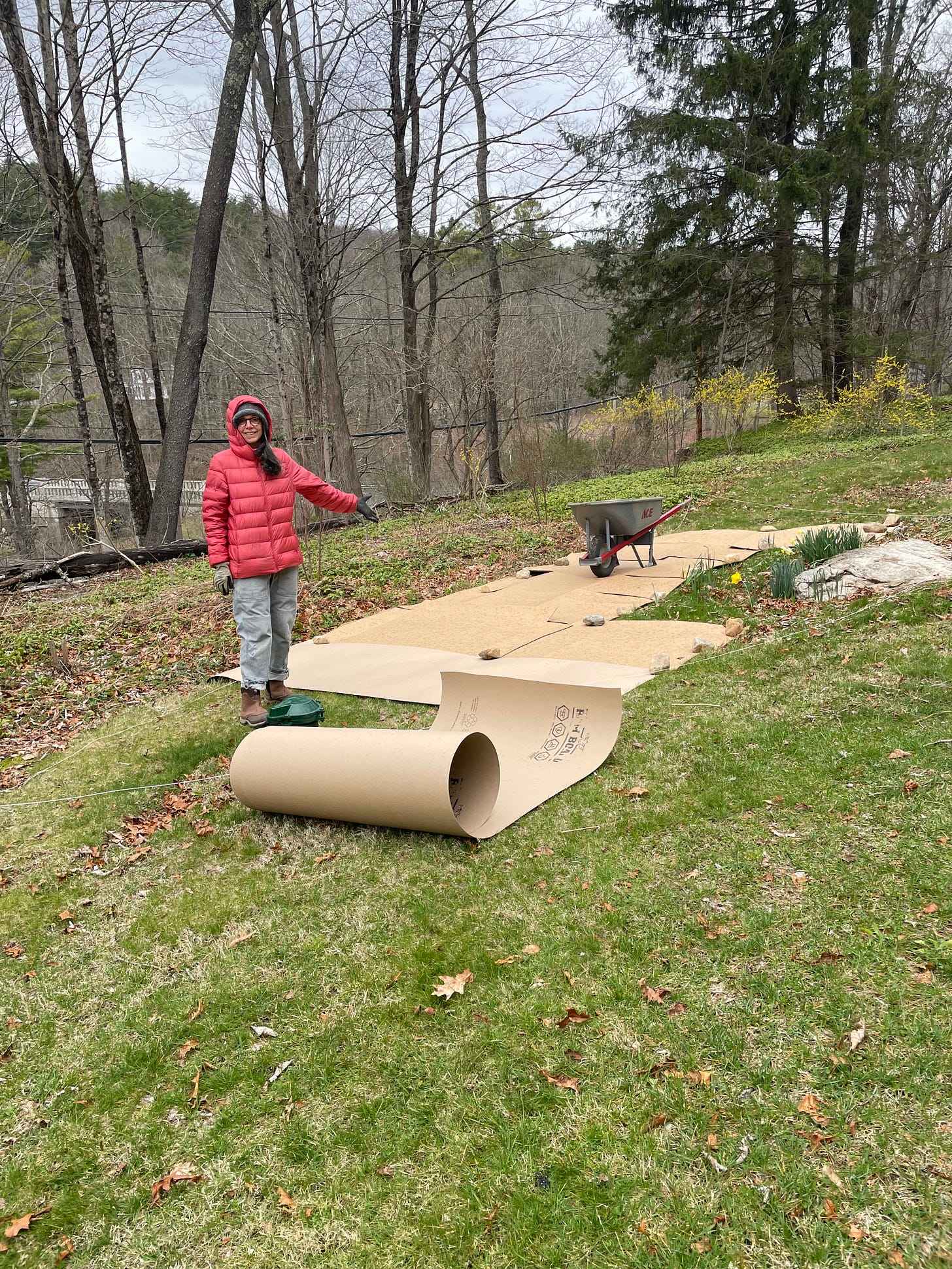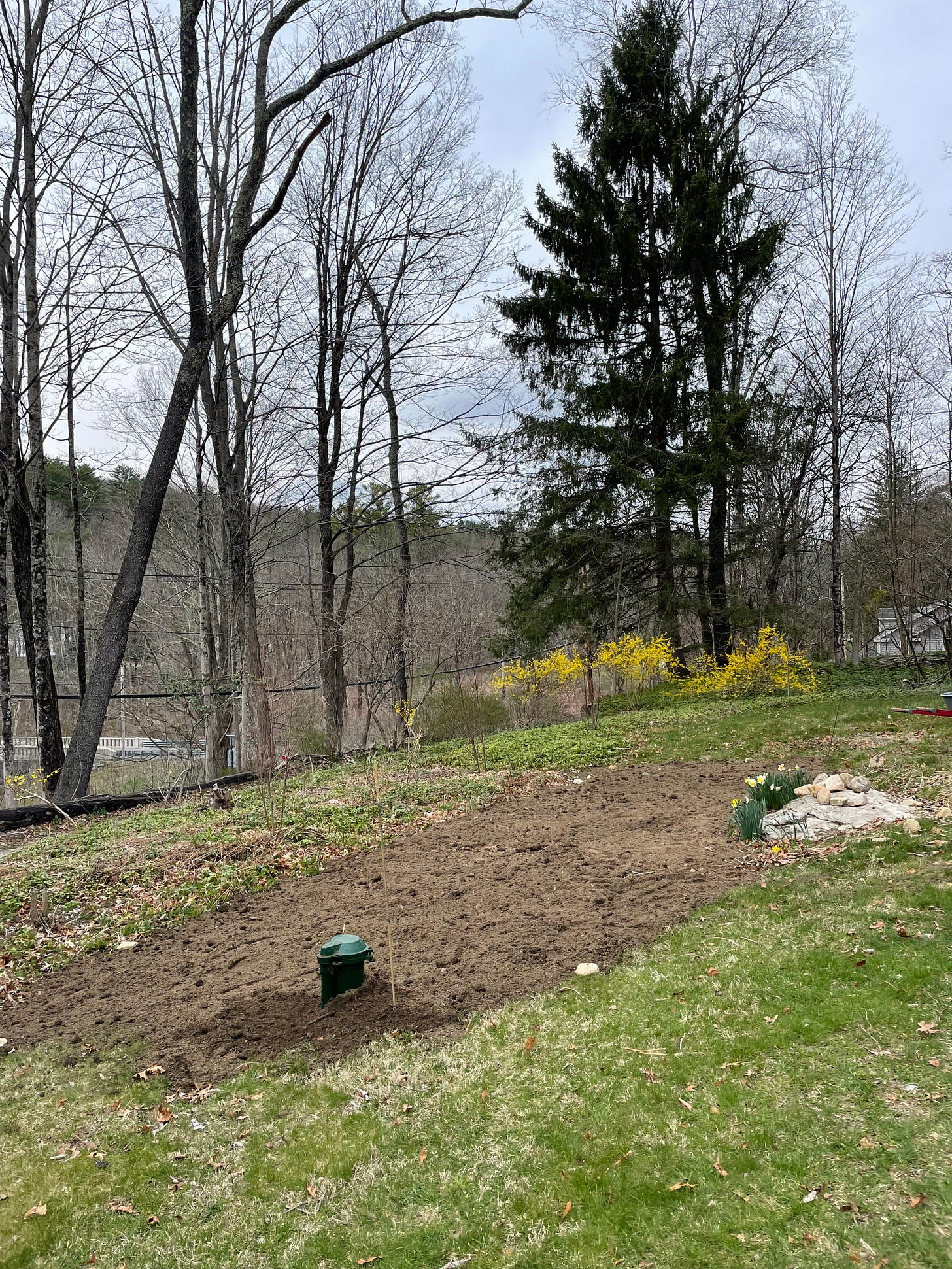Growing a pollinator meadow
We want more insect and bird friendly plants and fewer invasives in our field

When you move from an urban-sized lot of less than 6,000 square feet to 3 ½ acres of fields, native perennial borders and wooded hills you’re confronted with a new set of choices. This is particularly true if you like to garden. You quickly realize it's foolish to try to impose your will on all of your surroundings. You pick your battles and otherwise enjoy the serendipity of letting nature do its thing without any unneeded help.
We have two large fields, an inner field of a little under half an acre surrounded by a post and beam fence that we replaced a couple years ago. It keeps the dogs in and appears to be something of a deterrent to some of the larger critters around here, which include black bears, bobcats, deer, foxes, porcupines and, they say, fisher cats, though I’ve never seen one. This field we mow like proud suburban homeowners anywhere.
The second field is a bit larger. It has a beautiful middle-aged oak tree in the center surrounded by grasses, a scattering of welcome native plants like goldenrod, milkweed and yarrow, and a host of unwanted blackberry bramble, bittersweet and other invasives. We want more of the former and less of the latter in the field but want to get there in as hands-off a way as possible.
As for the woods, they just take care of themselves. Trees fall, branches snap, saplings emerge as they’ve done since the forest started returning to New England in the late 1800s after early European settlers had clear-cut much of the native woodlands for farmland, using the wood for lumber and paper. We try to maintain a little trail up Leffingwell Hill behind us so we can get to a clearing where we can get a nice view of Haystack Mountain to the south but otherwise leave the woods alone. I have visions of extending a trail into the adjoining Questing Reserve but that will have to wait for now.
Our focus this year is on the second field, and this week we started putting months of thought, reading and planning into action. For the past three years we’ve mowed this field twice a year, once in the spring and once again in the late fall. Except for maintaining a winding path through the grasses to ward off ticks we’ve largely let whatever grows there grow. (We did cut out some hardwood saplings three summers ago that were too thick for the mower to take down.) This summer we’re going to mow it more frequently, probably every three-to-five weeks, to a height of four inches, which is as high as our mower will go. The thinking is that repeated cutting will discourage a lot of the unwanted invasives and that they’ll give up over time, allowing more space and light for the grasses to flourish and further establish themselves. Next year, we hope to be able to mow it just once a year, in the spring.
We’re also going to try something we’ve wanted to do for some time, which is to create a pollinator meadow on part of this field. We’re going to start off small – about 300 square feet – and expand it over time. We want to avoid the trap of trying to take on too much at once. We’ll give it a chance this summer and grow it over the next year or so as the spirit moves us. Granted, the perennial beds on our property, which date back 50 years or more, are packed with native flowers that buzz with the sound of insect life during the warmer months. They do however require tending – weeding, pruning, mulching – which is all healthy and fun, though there’s something about the more natural environment of a meadow that appeals.
There’s been a movement in recent years to encourage homeowners to convert part or all of their lawns into meadows. Once established, meadows end the cycle of fertilizing, weed killing, mowing, watering and a host of other costly and time consuming lawn care practices that wreak havoc on natural ecosystems. They’re welcome habitats for insects, vital for the survival of endangered species like the Monarch butterfly and provide a crucial food source for birds. Plus meadows are beautiful, with long grasses that bend and wave in the breeze, dotted with bright native perennial flowers, buzzing with the humm of bees and other pollinators.Much has been written about the benefits of converting lawns into meadows for our planet. One proponent I came across was Owen Wormser who lives here in western Massachusetts and owns a landscape design and installation firm. I first heard Wormser on Joe Lamp’l’s “The Joe Gardener Show” podcast while driving to work in Washington, D.C., a couple years ago. I bought his book, Lawns into Meadows, last year and it’s a helpful guide packed with how-to tips and plant lists. It also doesn’t shy from making the case for change. “I’m convinced many of us could easily fall in love with meadows given the chance to stand in one, or watch one grow,” Wormser wrote. “If we do, we’ll see the dried-out look of a late summer lawn replaced by a richly textured, ever-shifting colorscape. And we’ll hear the roar of lawn mowers fall silent so the sound of chirping birds and crickets can rise up and be heard, and we all get to breathe a little easier.”
So we’re on our way to finding out.
We’re using the no-dig method to create our meadow. We placed a thick layer of cardboard over the area and then headed to Laurelbrook, a local stone, sand, gravel and soil firm that also produces organic compost milled from aged cow manure and straw from a nearby farm. It was a revelation, as was this gas-powered tubular monster that ground everything into a fine soil (I included a video below, a sign of how impressed I was.) We ended up buying 1 ½ cubic yards of a 50-50 blend of topsoil and compost that was dark and friable and looked totally hospitable to new plant life, or at least that’s what my untrained eye told me. It took four loads in the back of the pickup to get enough soil to cover the cardboard with about three to four inches. We no sooner had raked the soil smooth that it began to rain, which was a good omen. The rainwater will seep through the soil and into the cardboard, beginning the process of the cardboard’s disintegration that will unite the rich soil beneath with our new soil on top.
We should soon be receiving our seed from Prairie Moon Nursery in Winona, Minnesota, which specializes in native North American plants and seed mixes. We spoke to a very knowledgeable and helpful woman at the nursery, described what we wanted to do, and she helped us settle on a bag of their “Pollinator Palooza Seed Mix.” The mix is endorsed by the “bring back the pollinators” campaign sponsored by the Xerces Society, a nonprofit advocating for the preservation of the world’s invertebrates. What we’ll be getting is a blend of grasses and wildflowers designed to attract insects, though we understand that because we’re planting in the spring we’ll get just grasses this summer with the flowers emerging only next summer because they need to spend a winter in the cold soil first. Which means the story of this meadow is only beginning.






Your cardboard and compost looks delicious, and your farmhand is cute.
Great newsletter, Matt! So glad you are doing it. Love the pictures.